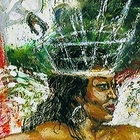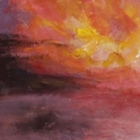Stranded at home during the summer of 2020, I was compelled to paint landscapes. At first I primarily responded to my immediate surroundings, but soon developed a desire to dig further and learn about the lives of trees and their shared existence with each other, the land, and me.
The Book of Hours/Ours project emerged as a result of curator Cynthia Hawkins’ invitation to have concurrent exhibitions at the Bertha V.B. Lederer Gallery at SUNY Geneso. It came to us during the height of the Covid-19 crisis in New Jersey when we were confined to our small American Bungalow on the side of the first ridge of the Watchung Mountains called First Mountain (20 minutes up the hill from downtown Newark). The bungalow is designed with windows all around that look out on the surrounding landscape. Because of the abrupt end to the activity of our busy lives, we often found ourselves in dialogue with one another while contemplating the beauty of the nature surrounding us. From conversations, we landed on the idea of a joint project rather than separate exhibitions. The title is a play on the Christian devotional book popular in the Middle Ages called A Book of Hours. Cicely had already embarked on a series of watercolors that were within a larger project called “Tomorrow will come on its green footsteps” (a line from a poem by Pablo Neruda) and she suggested we use the same format for our project. Victor, who does not consider himself a landscape painter nevertheless chose landscape as his subject. The works that comprise the project reference the structure of a printed book that is made up of a “signature” of sixteen pages. Eight works are by Cicely and eight works are by Victor.
These works range from references to current events, like Hurricane Maria and Hurricane Jose, to the murder of Faiyaz Narinedatt who resisted sexual assault by a gay man in Guyana. Other references are culturally specific to the Guyana landscape.
Clusters of colored jhandi flags mounted on bamboo poles are a common site in Hindu homes, temples, and public spaces near bodies of water to indicate a Hindu prayer ceremony (puja) has been performed. "Jhandi Flags", references the religious iconology of this ritual, transforming the canvas’s fabric with a heavy bath of glitter, sequins, and acrylic paint.
There is storybook quality to these paintings which include symbols and icons of what is "typically" Caribbean: the black stilt-walkers; the carnival queens; "old mas"players; and, of course, the omnipresent Guyanese flag.
"This twittering world: Contemporary painters celebrate T.S. Eliot's Four Quartets" at Francis Kyle Gallery, London June 14-July 21, 2011. These works resulted from studying the long poem, particularly the quartet "The Dry Salvages". These are the works on canvas (see record albums for additional works).






